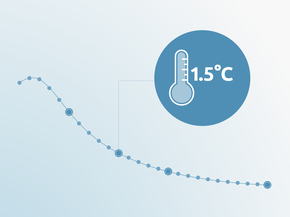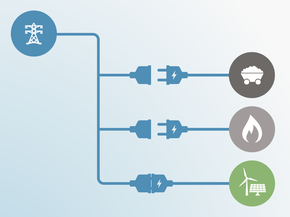Current Policy Projections
Economy-wide
Under current policies, emissions from all sectors (excluding LULUCF) are still projected to grow significantly, namely by about 60% above 2010 levels by 2030, reaching about 470 MtCO2 in 2030. Energy-related emissions are projected to increase by about 45% between 2010 and 2030.
Our analysis of current policies is based on the mitigation scenarios underlying the third National Communication of Argentina to the UNFCCC (Secretariat of Environment and Sustainable Development, 2015). Scenarios assuming a full implementation of the renewable targets and additional energy efficiency measures shown in our analysis are based on the Energy Scenarios from the Ministry of Energy (Ministry of Energy and Mining, 2018b).
Depending on these variables Argentina might overachieve its unconditional NDC target or miss it by a wide margin, unless additional action is taken.
Our policy projections, as well as the new scenarios from the Ministry of Environment, do not yet specifically reflect the recently implemented carbon tax, and no studies exist quantifying the impact.
Energy supply
The new government of President Mauricio Macri has introduced policies, including a renewable energy law and a biofuels law (Government of Argentina, 2015b & Government of Argentina, 2016b). The new renewable energy law (Law 27191), published at the end of 2015, aims to increase the share of renewables (including hydro smaller than 50 MW) in total power generation to 20% by 2025 (Government of Argentina, 2015). An auctioning scheme—RenovAr—supports this target. Up to now, three auctioning rounds were held, leading to contracting of 4.5 GW of renewable electricity (Ministry of Energy and Mining, 2018a). Concerns about grid access have been raised, potentially causing a delay in the grid connection of the contracted capacities and making additional bidding rounds more difficult to realise. The national grid operator CAMESSA has recognised this issue and is working on the extension of the electricity grid (CAMMESA, 2018; Télam, 2017). However, at this point in time CAT could not find an indication of a clear timeline, and the CAMMESA documentation specifically states that no legal claims can be made based on a delay in access to the electricity grid (CAMMESA, 2018).
Available projections vary significantly in their assumptions on capacity additions and electricity demand. The following table summarises the three scenarios considered and compares the indicators for the year 2025 to a scenario considering only capacities additions currently underway (contracted).

The “Capacities underway”-scenario would result in similar emission levels from the electricity sector as the “Mitigation scenarios 2015”, the basis for the third National Communication.
While the new energy scenarios represent a detailed representation of possible future planning for the energy sector, additional actions need to be taken to achieve the share of low carbon electricity supply assumed by the scenarios. One important area of improvement is the above-mentioned grid integration: the energy scenarios assume a large amount of additional wind capacity in Patagonia (Ministry of Energy and Mining, 2018b). Investments in the grid will be critical to transport the electricity generated to urban centres.
In December 2017, Argentina adopted a carbon tax covering all fossil fuels sold in Argentina, based on a price of 10 USD/tCO2e (FARN, 2017; Ministerío de Justicia y Derechos Humanos, 2017). The impact of the tax on emissions has not yet been quantified, but some international sources suggest significantly higher carbon prices are required for Paris compatibility (at least US$40–80/tCO2 by 2020 andUS$50–100/tCO2 by 2030 (Stiglitz et al., 2017).
An earlier proposal in Argentina included a carbon price of 25 USD/tCO2e but the final decision was for a much weaker tax. National NGOs have criticised the final rule as too unambitious and merely a tool to align with international activities to increase the chances for accession to the OECD, rather than an instrument to safeguard the environment (FARN, 2017). The law distributes the tax revenues to different areas, most not directly linked to climate change or environmental issues (Ministerío de Justicia y Derechos Humanos, 2017).
Finally, the biofuels law (Decree 543/16) adopted in March 2016 requires a minimum 12% of bioethanol blend in transport fuels from 2016.
Agriculture and LULUCF
Emissions from the agriculture and cattle-ranching sector emissions are still projected to increase by about 30% by 2030 (Secretariat of Environment and Sustainable Development, 2015), and will account for almost 40% of the total GHGs in 2030, with a major share stemming from cattle. Considering the high level of methane emissions, combined with the associated deforestation this activity has caused, the agriculture sector offers great potential for Argentina to constrain its emissions (Secretariat of Environment and Sustainable Development, 2015). On the other hand, the LULUCF sector is reported as a source of emissions projected to decrease in the future (Secretariat of Environment and Sustainable Development, 2015). Argentina has also worked on improving its LULUCF accounting methodology in recent years, leading to a change in the sectoral results compared to previous years reports (Ministry of the Environment and Sustainable Development, 2015).
As part of its 2nd Biennial Update Report (BUR), Argentina published an update of its national emissions inventory until 2014 (Government of Argentina, 2017). The report includes an updated historical series of emissions per sector: the numbers differ from those of former emissions inventories due to revisions and corrections of the methodology used, mostly in the agriculture and LULUCF sectors. The newly published numbers are, on average, about 50 MtCO2e lower than those that were published in the 3rd National Communication. We harmonised the emissions projections from the National Communication to the new historical emissions from BUR, which brought down the emissions projections for 2030 by around 45 MtCO2e, compared to the numbers in our previous assessment.
Further analysis
Latest publications
Stay informed
Subscribe to our newsletter






